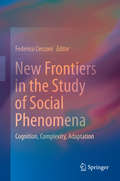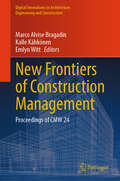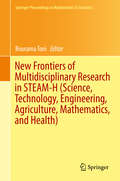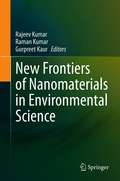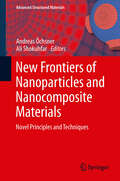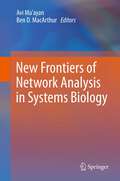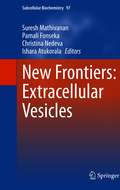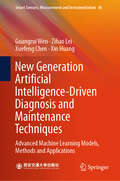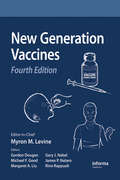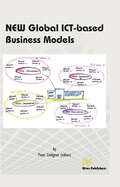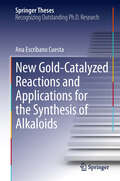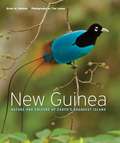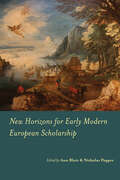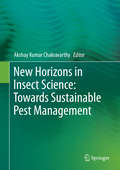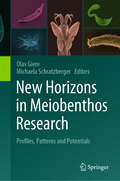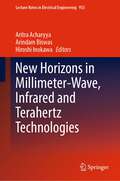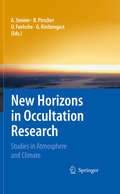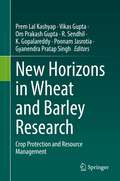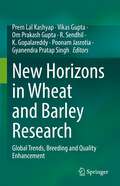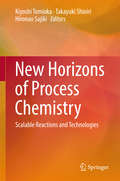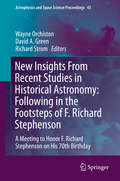- Table View
- List View
New Frontiers in the Study of Social Phenomena: Cognition, Complexity, Adaptation
by Federico CecconiThis book studies social phenomena in a new way, by making judicious use of computer technology. The book addresses the entire spectrum of classic studies in social science, from experiments to the computational models, with a multidisciplinary approach. The book is suitable for those who want to get a picture of what it means to do social research today, and also to get an indication of the major open issues. The book is connected to a database of code for simulations, experimental data and allows to activate a subscription to a teaching tool using NetLogo, a programming language widely used in the social studies. The authors are researchers with first-hand experience research projects, both basic and applied. The work will be useful for those who want to understand more of the social, economic and political phenomena via computer applications.
New Frontiers of Biostatistics and Bioinformatics (ICSA Book Series in Statistics)
by Ding-Geng Chen Yichuan ZhaoThis book is comprised of presentations delivered at the 5th Workshop on Biostatistics and Bioinformatics held in Atlanta on May 5-7, 2017. Featuring twenty-two selected papers from the workshop, this book showcases the most current advances in the field, presenting new methods, theories, and case applications at the frontiers of biostatistics, bioinformatics, and interdisciplinary areas.Biostatistics and bioinformatics have been playing a key role in statistics and other scientific research fields in recent years. The goal of the 5th Workshop on Biostatistics and Bioinformatics was to stimulate research, foster interaction among researchers in field, and offer opportunities for learning and facilitating research collaborations in the era of big data. The resulting volume offers timely insights for researchers, students, and industry practitioners.
New Frontiers of Construction Management: Proceedings of CMW 24 (Digital Innovations in Architecture, Engineering and Construction)
by Kalle Kähkönen Marco Alvise Bragadin Emlyn WittThis book comprises the select proceedings of the 3rd Construction Management Workshop (CMW 24), New Frontiers of Construction Management, held in Ravenna, Italy on November 7-8, 2024. It highlights key research topics that could be drivers of change and innovation in the management of the construction and building processes in its various stages, including design, construction, operation and maintenance, disposal and reuse. It represents a contribution to the debate and an introduction to new methods and tools addressing building production and management. The contributions focus on the use of methodologies for Construction Project Management, especially those that have witnessed recent developments because of the digitalization of building processes, the use of Artificial Intelligence and the search for environmental sustainability. Topics include AI and Digitalization of building processes, Building Information Modelling and Built Heritage, Construction Project Management and Lean Construction, Off-site Construction, Occupational Health and Safety management, Environmental impacts, Circular Economy, Low carbon, Life Cycle Assessment in construction projects.
New Frontiers of Multidisciplinary Research in STEAM-H (Science, Technology, Engineering, Agriculture, Mathematics, and Health)
by Bourama ToniThis highly multidisciplinary volume contains contributions from leading researchers in STEAM-H disciplines (Science, Technology, Engineering, Agriculture, Mathematics and Health). The volume explores new frontiers in multidisciplinary research, including: the mathematics of cardiac arrhythmia; brain research on working memory; penalized ordinal regression to classify melanoma skin samples; forecasting of time series data; dynamics of niche models; analysis of chemical moieties as anticancer agents; study of gene locus control regions; qualitative mathematical modelling; convex quadrics and group circle systems; remanufacturing planning and control; complexity reduction of functional differential equations; computation of viscous interfacial motion; and differentiation in human pluripotent stem cells. An extension of a seminar series at Virginia State University, the collection is intended to foster student interest and participation in interdisciplinary research and to stimulate new research. The content will be of interest to a broad spectrum of scientists, mathematicians and research students working in interdisciplinary fields including the biosciences, mathematics, engineering, neurosciences and behavioral sciences.
New Frontiers of Nanomaterials in Environmental Science
by Rajeev Kumar Raman Kumar Gurpreet KaurThis book provides the detail information about nanoparticles, their types, characterization techniques such as TEM, FESEM, AFM, XRD etc. nanogenotoxicity, metal and metal oxide nanoparticle’s toxicity, physical and chemical characterization of nanomaterials, entry routes, cell-nano interaction studies, possible impacts to the human kind, and on the methods of evaluating the toxicity. It puts together comprehensive and up-to-date information about sustainable approaches in making an eco-friendly environment using advanced nanotechnologies. It educated readers about the new frontiers and scope of employing various state-of-art nano-technologies to clean-up and save our environment. This book will be of interest to teachers, researchers, environmental biotechnologists, capacity builders and policymakers. Also the book serves as additional reading material for undergraduate and graduate students of agriculture, environmental sciences, environmental engineering and biotechnology.
New Frontiers of Nanoparticles and Nanocomposite Materials
by Andreas Öchsner Ali ShokuhfarThe development of nanomaterials opens the possibility for new materials with outstanding properties compared to classical engineering materials. These materials can find applications in different fields such as medical treatment or structural mechanics. This monograph focuses on two major groups of nanomaterials, i.e.nanoparticels and nanocomposites. Nanopartices, for example in the form of hollow particles, allow for new possibilities in drug delivery. Different aspects of nanoparticles ranging from manufacturing to modeling and simulation are covered. Nanocomposite materials are formed by mixing two or more dissimilar materials at the nanoscale in order to control and develop new and improved structures and properties. The properties of nanocomposites depend not only on the individual components used but also on the morphology and the interfacial characteristics. Nanocomposite coatings and materials are one of the most exciting and fastest growing areas of research and novel properties being continuously developed which are previously unknown in the constituent materials. Thus, the second part of this monograph gives an overview on the latest developments in the area of composites and coatings based on nanomaterials.
New Frontiers of Network Analysis in Systems Biology
by Avi Ma'Ayan Ben D. MacarthurThe rapidly developing field of systems biology is influencing many aspects of biological research and is expected to transform biomedicine. Some emerging offshoots and specialized branches in systems biology are receiving particular attention and are becoming highly active areas of research. This collection of invited reviews describes some of the latest cutting-edge experimental and computational advances in these emerging sub-fields of systems biology. In particular, this collection focuses on the study of mammalian embryonic stem cells; new technologies involving mass-spectrometry proteomics; single cell measurements; methods for modeling complex stochastic systems; network-based classification algorithms; and the revolutionary emerging field of systems pharmacology.
New Frontiers: Extracellular Vesicles (Subcellular Biochemistry #97)
by Suresh Mathivanan Pamali Fonseka Christina Nedeva Ishara AtukoralaThe field of extracellular vesicles (EVs) has progressed immensely in recent times with evidences highlighting their importance in physiology and pathology. This book entails extensive reflective literature on many subtypes of EVs including exosomes, exomeres, ectosomes, apoptotic vesicles, bacterial EVs and fungal EVs. The book further discusses the biogenesis and secretion of these EVs, detailing the biological pathways and proteins involved. Research investigating the biological functions of EVs is rapidly increasing and the current knowledge around their role in progression of diseases such as cancer, neurodegeneration and metabolic disorders is discussed in multiple chapters. The implications of EVs in intercellular communication and the significance of biologically active cargo carried within these EVs are further examined. Moreover, the numerous applications of EVs in diagnostics and treatment of diseases are reviewed in detail, particularly their potential as biomarkers and drug delivery vehicles. Taken together, this book is a compilation of the key implications of EVs that are secreted by virtually all cell types. Readers will gain a perspective into the biology, functions and applications of EVs and their constantly evolving knowledge base.
New Generation Artificial Intelligence-Driven Diagnosis and Maintenance Techniques: Advanced Machine Learning Models, Methods and Applications (Smart Sensors, Measurement and Instrumentation #46)
by Xuefeng Chen Xin Huang Guangrui Wen Zihao LeiThe intelligent diagnosis and maintenance of the machine mainly includes condition monitoring, fault diagnosis, performance degradation assessment and remaining useful life prediction, which plays an important role in protecting people's lives and property. In actual engineering scenarios, machine users always hope to use an automatic method to shorten the maintenance cycle and improve the accuracy of fault diagnosis and prognosis. In the past decade, Artificial Intelligence applications have flourished in many different fields, which also provide powerful tools for intelligent diagnosis and maintenance. This book highlights the latest advances and trends in new generation artificial intelligence-driven techniques, including knowledge-driven deep learning, transfer learning, adversarial learning, complex network, graph neural network and multi-source information fusion, for diagnosis and maintenance of rotating machinery. Its primary focus is on the utilization of advanced artificial intelligence techniques to monitor, diagnose, and perform predictive maintenance of critical structures and machines, such as aero-engine, gas turbines, wind turbines, and machine tools. The main markets of this book include academic and industrial fields, such as academic institutions, libraries of university, industrial research center. This book is essential reading for faculty members of university, graduate students, and industry professionals in the fields of diagnosis and maintenance.
New Generation Vaccines
by Myron M. LevineHighlighting the latest activities and initiatives of prominent organizations working in the vaccine industry such as the Bill and Melinda Gates Foundation, The Global Alliance for Vaccines and Immunization, WHO, UNICEF, the World Bank, New Generation Vaccines, Fourth Edition, details steps developing countries have taken toward research, development, manufacture, and regulation of several new vaccines for widespread use.This text will:cover the current state-of-the-art techniques in vaccine development – including the successes and the failurestrace vaccine development from the bench to public health with regard to both FDA and European Union regulationsinvestigate improved methods for immunizing large populations, and the use of needless vaccinationsdiscuss the advancements in the heavily government-funded areas for developing vaccines against potential bioterror and infectious disease agents as well as the immunization of large population bases for diseases like: Anthrax, Smallpox, Ebola, West Nile, SARS, and othersUpdated throughout with new cutting-edge information on recent breakthroughs and developments.NEW TO GENERATION VACCINES, FOURTH EDITION:highlights the latest activities of prominent organizations in the vaccine industrycovers the current techniques in vaccine developmentinvestigates improved methods for immunizing large populations
New Global Ict-Based Business Models (River Publishers Series In Multi Business Model Innovation, Technologies And Sustainable Business Ser.)
by Peter LindgrenThe New Global Business model (NEWGIBM) book describes the background, theory references, case studies, results and learning imparted by the NEWGIBM project, whichis supported by ICT, to a research group during the period from 2005-2011. The book is a result of the efforts and the collaborative work between SMEs, consultancies and researchers across various lines of business, competences and research domains. The book commences with a theoretical discussion of the business model and its innovationliterature and explains how this was a collaborative study by researchers from three Danish Universities. The book continues by describing, analyzing and showing how NEWGIBM was implemented in SMEs in different industrial companies/networks. Based on this effort, the researchers try to describe and analyze the current context, experience of NEWGIBM and finally the emerging scenarios of NEWGIBM.The NEWGIBM book serves as a part of the final evaluation and documentation of the NEWGIBM project and is supported by results from the following projects: M-commerce, Global Innovation, Global Ebusiness & M-commerce, The Blue Ocean project, International Center for Innovation and Women in Business, NEFFICS, which providedinformation about the innovating business models funded by Ministry of Science and Innovation Denmark, Ministry of Economics Denmark, EU Social Fund, EU KASK program and EU 7 Framework program Internet of Things. This book adds new knowledge to the global business models based on ICT.
New Gold-Catalyzed Reactions and Applications for the Synthesis of Alkaloids
by Ana Escribano CuestaAna Escribano Cuesta's thesis presents a detailed study of the inter- and intramolecular reactions of carbonyl compounds with 1,6-enynes using gold (I) complexes. An important part of the work involved streamlining the variables that allow the selective synthesis of different products such as tricyclic compounds, dihydropyrans, 1,3-dienes or cyclobutenes. The second chapter highlights the importance and difficulties in synthesising a cyclobutene subunit and the author includes a detailed description of how the products were prepared. The final chapter outlines the synthesis of lundurines using methodology developed by the author's research group for intramolecular gold-catalyzed cyclization of indoles with alkynes. The lundurine products developed in this work show significant in vitro cytoxicity toward B16 melanoma cells. The work in this thesis has led to a number of publications in high-profile chemistry journals.
New Guinea: Nature and Culture of Earth's Grandest Island
by Bruce M. Beehler Tim LamanAn enthralling exploration of the biologically richest island on Earth, featuring more than 200 spectacular color images by award-winning National Geographic photographer Tim LamanIn this beautiful book, Bruce Beehler, a renowned author and expert on New Guinea, and award-winning National Geographic photographer Tim Laman take the reader on an unforgettable journey through the natural and cultural wonders of the world's grandest island. Skillfully combining a wealth of information, a descriptive and story-filled narrative, and more than 200 stunning color photographs, the book unlocks New Guinea's remarkable secrets like never before.Lying between the Equator and Australia's north coast, and surrounded by the richest coral reefs on Earth, New Guinea is the world's largest, highest, and most environmentally complex tropical island—home to rainforests with showy rhododendrons, strange and colorful orchids, tree-kangaroos, spiny anteaters, ingenious bowerbirds, and spectacular birds of paradise. New Guinea is also home to more than a thousand traditional human societies, each with its own language and lifestyle, and many of these tribes still live in isolated villages and serve as stewards of the rainforests they inhabit.Accessible and authoritative, New Guinea provides a comprehensive introduction to the island's environment, animals, plants, and traditional rainforest cultures. Individual chapters cover the island's history of exploration; geology; climate and weather; biogeography; plantlife; insects, spiders, and other invertebrates; freshwater fishes; snakes, lizards, and frogs; birdlife; mammals; paleontology; paleoanthropology; cultural and linguistic diversity; surrounding islands and reefs; the pristine forest of the Foja Mountains; village life; and future sustainability.Complete with informative illustrations and a large, detailed map, New Guinea offers an enchanting account of the island's unequalled natural and cultural treasures.
New Horizons for Early Modern European Scholarship
by Ann Blair and Nicholas PopperAn illuminating exploration of the new frontiers—and unsettled geographical, temporal, and thematic borders—of early modern European history.The study of early modern Europe has long been the source of some of the most creative and influential movements in historical scholarship. New Horizons for Early Modern European Scholarship explores recent developments in historiography both to exhibit the field's continuing vibrancy and to highlight emerging challenges to long-assumed truths. Essays examine • how key ideas and intellectual practices arose, circulated through scholarly culture, and gave way to subsequent forms • Europe's transforming relationship with Asia, the Americas, Africa, and the rest of the world• how overlooked evidence illuminates vital but obscured people, practices, and objects • connections between disciplines, types of sources, time periods, and placesOpening up emerging possibilities, this book demonstrates that early modern European scholarship remains a source for groundbreaking historical insights and methodologies that would benefit the study of any time and place. Contributors: Alexander Bevilacqua, Ann Blair, Daniela Bleichmar, William J. Bulman, Frederic Clark, Anthony Grafton, Jill Kraye, Yuen-Gen Liang, Elizabeth McCahill, Nicholas Popper, Amanda Wunder
New Horizons for Industry 4.0 in Modern Business (Contributions to Environmental Sciences & Innovative Business Technology)
by Anand Nayyar Rudra Rameshwar Mohd NavedThis book discovers what it will take to reindustrialize the previous industrial powerhouses in order to offset the advantages of cheap labor suppliers dominating the industrial sector by exploring the current situation of the production, processing, and manufacturing industries. The Internet of Things (IoT), Big Data, Cyber-Physical Systems (CPS), and Cloud Computing, Cyber Security, Cobotics, Automation, AI, 3D Printing and Additive Manufacturing, SDN, Blockchain technologies are outlined in this unique and comprehensive book, which has true potential for professionals, researchers, policymakers, and book users. New Horizons for Industry 4.0 in Modern Business encompass trends in business and technology globally that may completely alter how manufacturing and production are conducted. What you will discover: Learn about the Industrial Internet of Things and the Industrial Internet. Learn about the technologies that must develop to support Industry 4.0 and what is being done right now to make that happen. In this book, the topic of Industry 4.0 is covered in detail, and it even moves on to concepts of Digital Twins to boost output and create Industrial Internet of Things. With the development of new digital industrial technology, or "Industry 4.0," it is now feasible to collect and analyze data from many machines, resulting in processes that are quicker, more adaptable, and more efficient, producing things of higher quality while spending less money. The manufacturing revolution will boost productivity, alter economics, promote industrial development, and alter workforce demographics, ultimately altering the competitiveness of businesses and areas. Although advanced digital technology is being employed in manufacturing, Industry 4.0 will completely change how things are done. Greater production efficiencies will result, and conventional connections between suppliers, manufacturers, and consumers—as well as between people and machines—will shift. Industry 4.0 is changing the business process. This disruptive technology is radically changing the way businesses/manufacturing is conducted. It will give machines that little bit of intuition with the help of robotics, 3D printing, artificial intelligence, augmented reality, and virtual reality—that will help them do mindless and repetitive jobs without human intervention, allowing humans to focus more on their core competencies.
New Horizons in Fundamental Physics
by Mirko Schäfer Stefan SchrammThis volume presents the state-of-the-art in selected topics across modern nuclear physics, covering fields of central importance to research and illustrating their connection to many different areas of physics. It describes recent progress in the study of superheavy and exotic nuclei, which is pushing our knowledge to ever heavier elements and neutron-richer isotopes. Extending nuclear physics to systems that are many times denser than even the core of an atomic nucleus, one enters the realm of the physics of neutron stars and possibly quark stars, a topic that is intensively investigated with many ground-based and outer-space research missions as well as numerous theoretical works. By colliding two nuclei at very high ultra-relativistic energies one can create a fireball of extremely hot matter, reminiscent of the universe very shortly after the big bang, leading to a phase of melted hadrons and free quarks and gluons, the so-called quark-gluon plasma. These studies tie up with effects of crucial importance in other fields. During the collision of heavy ions, electric fields of extreme strength are produced, potentially destabilizing the vacuum of the atomic physics system, subsequently leading to the decay of the vacuum state and the emission of positrons. In neutron stars the ultra-dense matter might support extremely high magnetic fields, far beyond anything that can be produced in the laboratory, significantly affecting the stellar properties. At very high densities general relativity predicts the stellar collapse to a black hole. However, a number of current theoretical activities, modifying Einstein's theory, point to possible alternative scenarios, where this collapse might be avoided. These and related topics are addressed in this book in a series of highly readable chapters. In addition, the book includes fundamental analyses of the practicalities involved in transiting to an electricity supply mainly based on renewable energies, investigating this scenario less from an engineering and more from a physics point of view. While the topics comprise a large scope of activities, the contributions also show an extensive overlap in the methodology and in the analytical and numerical tools involved in tackling these diverse research fields that are the forefront of modern science.
New Horizons in Insect Science: Towards Sustainable Pest Management
by Akshay Kumar ChakravarthyInsect science is fast changing as insects are evolving to a plethora of newer chemical molecules, climate change, management tactics and transformation of the landscapes. Through the International Conference, the editors have attempted to gather together newer aspects of Insect Sciences like Insect Taxonomy, DNA Barcoding, Physiology, Toxicology, Vectors and their Management, Molecular Biology, RNA interference in Pest Management, Semiochemicals and Pest Management using Host Plant Resistance and Biological Control appropriated especially for the developing world. Both basic and applied aspects of insect science have been included to stimulate comprehensive studies on insect science. The book not only deals with insect science but also environmental and ecological aspects in the hope that the book will be of immense use to students, researchers, extension workers, planners, administrators, farmers and other end users. The Chapters on diversified aspects of Insect Science are contributed by leading scientists for the coming 21st century in which entomology is witnessing a dramatic advancement in management of pests through in-depth investigations. The dimensions of Insect Science covered in the book are pest management approaches that can be adopted worldwide with ascent on sustainability.
New Horizons in Meiobenthos Research: Profiles, Patterns and Potentials
by Olav Giere Michaela SchratzbergerSince research on meiobenthos was last compiled in a textbook (2008/2009), the number of theoretical and applied studies has been growing rapidly. Supported by new methods and digital evaluation, meiobenthology has developed into a wide field, with more and more researchers studying cross-disciplinary aspects. New perspectives were summarized in a booklet (2019) to draw attention to promising research directions. The present book, written by leading experts, is a compilation of new thinking, data, methods and approaches in many relevant fields of recent meiobenthos research. The topics addressed range from bacteria and biofilms to globally changing processes, from polar regions to the deep-sea and from freshwater ecosystems to the ocean. So, this book is not simply another meiobenthos textbook - it is an attempt to identify new horizons in meiobenthos research, driven by the vision of advancing knowledge and understanding of benthic ecosystems.
New Horizons in Millimeter-Wave, Infrared and Terahertz Technologies (Lecture Notes in Electrical Engineering #953)
by Arindam Biswas Aritra Acharyya Hiroshi InokawaThis book presents recent and upcoming technological advancements in millimeter-wave (mm-wave), infrared (IR) and terahertz (THz) frequency spectrums. The scope of this book includes a significantly long portion of the electromagnetic spectrum, starting from the mm-waves (i.e. 30 GHz) and extended up to the end of the near-IR spectrum (i.e. 450 THz). Most significant aspect of this portion of the electromagnetic spectrum is that it includes a frequency regime where the gradual technological transition from electronics to photonics occurred. The book especially focuses on the recent advancements and several research issues related to materials, sources, detectors, passive circuits, advanced signal processing and image processing algorithms for mm-wave, IR and THz frequency bands. The book covers a very wide range of readers from basic science to technological experts as well as research scholars.
New Horizons in Occultation Research
by Gottfried Kirchengast Ulrich Foelsche Andrea Steiner Barbara PirscherThe current contribution can be seen as a sequel of the Springer books "Occultations for Probing Atmosphere and Climate", edited by G. Kirchengast, U. Foelsche, and A.K. Steiner, published in 2004, and "Atmosphere and Climate - Studies by Occultation Methods", edited by U. Foelsche, G. Kirchengast, and A.K. Steiner. While these books contained scientific results presented at the 1st and 2nd OPAC workshop in Graz (Sep 2002, Sep 2004), the current contribution features new results, presented at the 3rd OPAC workshop in Graz (Sep 2007), in the form of peer-reviewed papers.
New Horizons in Wheat and Barley Research: Crop Protection and Resource Management
by Vikas Gupta Prem Lal Kashyap Gyanendra Pratap Singh Om Prakash Gupta R. Sendhil K. Gopalareddy Poonam JasrotiaThis book discusses the research progress on pathology, entomology, nematology, and resource management of wheat and barley crops. The volume summarizes the research progress and discusses the future perspectives based on current understanding of the existing issues and advancing cutting-edge technologies in the field. The book aims to help in deciding future research and development agenda by devising better strategies and techniques to cultivate these crops under clean and sustainable environment. Through this book an international group of leading wheat and barley researchers unveil the emerging concepts and issues related to biotic stresses and resource management and offers latest glimpses of technological needs and resource optimization in wheat and barley production system. Also, key topics such as frontier mechanization technologies, improved precision farming techniques, pluralistic extension and policy interventions for enhancing the resource efficiency and livelihood security of the farmers are explored here. This book is of interest to teachers, researchers, molecular breeders, cereal biochemists and biotechnologists, policymakers and professionals working in the area of wheat and barley research, food and cereal industry. Also, the book serves as an additional reading material for undergraduate and graduate students of agriculture and food sciences. National and international agricultural scientists, policy makers will also find this book to be a useful read.Volume 1 of New Horizons in Wheat and Barley Research covers global trends, breeding and quality enhancement.
New Horizons in Wheat and Barley Research: Global Trends, Breeding and Quality Enhancement
by Vikas Gupta Prem Lal Kashyap Gyanendra Pratap Singh Om Prakash Gupta R. Sendhil K. Gopalareddy Poonam JasrotiaThis book outlines comprehensive information on the global trends, policies, research priorities and frontier innovations made in the research domain of breeding, biotechnology, biofortification and quality enhancement of wheat and barley. With contributions by international group of leading wheat and barley researchers, this book offers data-based insights along with a holistic view of the subject and serve as a vital resource of information for scientists engaged in breeding future high-yielding biofortified varieties. It catalogs both conventional as well as modern tools for gene identification and genome editing interventions for enhancing the yield, grain quality, disease and pest resistance, nutrient-use efficiency and abiotic stress tolerance. The prospects of processing high quality wheat end-products with long term storage and high nutritional quality are also discussed. This book is of interest to teachers, researchers, molecular breeders, cereal biochemists and biotechnologist, policymakers and professionals working in the area of wheat and barley research, food and cereal industry. Also, the book serves as an additional reading material for the undergraduate and graduate students of agriculture and food sciences. National and international agricultural scientists, policy makers will also find this book to be a useful read. Volume 2 of New Horizons in Wheat and Barley Research covers topics in crop protection and resource management.
New Horizons of Process Chemistry
by Takayuki Shioiri Kiyoshi Tomioka Hironao SajikiThe methodologies and technologies adaptable to process chemistry are the focus of this unique book, as new catalysts, reactions, and methods for the synthesis of functional materials are dealt with in depth for the first time. Those materials take in pharmaceuticals, agrochemicals, functional materials, chemical raw materials, and other substances in the field of process chemistry including green chemistry. Process chemistry underpins the competitiveness of chemical and pharmaceutical industries, but its stagnation is estimated to cause industrial depression and excessive loss. For that reason, chemists focus on process chemistry consistently so that the development of novel and efficient new reactions and technologies provides an essential stimulus. In addition, this volume describes the important development of selected new synthetic devices for process development and the process design for a larger scale, thus furnishing a valuable source for all who are engaged in process chemistry.
New Information Technology in Education (Routledge Revivals #32)
by David HawkridgeFirst published in 1983, New Information Technology in Education surveyed developments in the field of information technology and demonstrated how it could be used to improve the quality of education. The book considered the experience of a wide range of countries, including the United States, Japan and those in Europe. While explaining the potential improvements that the new technology could bring, this book also reviewed the problem areas and helped educationalists to evaluate the relevance of the new technology for their own work. In an age of teaching via Zoom videos, it is interesting to take a look at a time when information technology in education was at its nascent stage. This book will be of interest to teachers and students of history, education, technology and pedagogy.
New Insights From Recent Studies in Historical Astronomy: Following in the Footsteps of F. Richard Stephenson
by Wayne Orchiston David A. Green Richard StromThis book contains papers from a conference held to celebrate the 70th birthday of one of the world's foremost astronomical historians, Professor F. Richard Stephenson, the latest recipient of the American Astronomical Society's highest award for research in astronomical history, the LeRoy Doggett Prize. Reflecting Professor Stephenson's extensive research portfolio, this book brings together under one cover papers on four different areas of scholarship: applied historical astronomy (which Stephenson founded); Islamic astronomy; Oriental astronomy and amateur astronomy. These papers are penned by astronomers from Canada, China, England, France, Georgia, Iran, Japan, Lebanon, the Netherlands, Portugal, Thailand and the USA Its diverse coverage represents a wide cross-section of the history of astronomy community. Under discussion are ways in which recent research using historical data has provided new insights into auroral and solar activity, supernovae and changes in the rotation rate of the Earth. It also presents readers with results of recent research on leading historical figures in Islamic and Oriental astronomy, and aspects of eighteenth and nineteenth century Australian, British, German and Portuguese amateur astronomy, including the fascinating 'amateur-turned-professional syndrome'.
